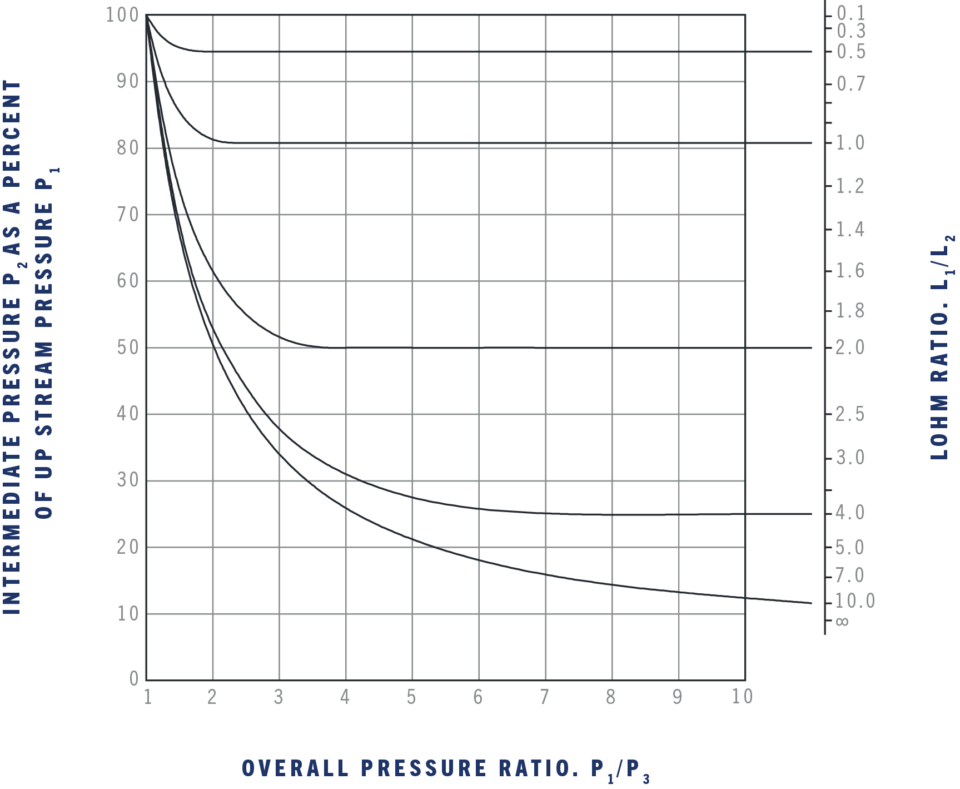When gas flow passes through restrictors in series, the pressure drops are not evenly distributed. This is caused by the compressibility of the gas and generally results in higher pressure drops at the downstream restrictors. Thus, it becomes difficult to calculate the intermediate pressure between series restrictors flowing gas without using a trial-and-error-process. To simplify this calculation, the chart below may be used when the Lohm rates of the applicable restrictors are known.
The chart below solves for the absolute pressure between two restrictors as a percentage of the supply pressure. To solve a problem, simply follow the graph line corresponding to the Lohm ratio, L1/L2, until it crosses the overall pressure ratio, P1/P3. Then read horizontally across to the left-hand scale to obtain the value of P2 as a percentage of the upstream absolute pressure, P1.
The following will allow solutions to be obtained for series restrictor problems even when Lohm or pressure ratios are off-scale:
1. When the Lohm ratio is less than 0.1, then P2 = P1.
2. When the Lohm ratio is less than 8.0, then the solution for a pressure ratio greater than 10 is the same as at 10.
3. When the Lohm ratio is greater than 1.5, then the solution at high values of the pressure ratio is such that the ratio P2 /P1 is equal to the reciprocal of the Lohm ratio.


EXAMPLE:
Find the intermediate pressure between two restrictors with an upstream pressure 72 psia, exhausting to atmosphere at 14.7 psia.
L1 = 2000 Lohms
L2 = 500 Lohms
Calculate the Lohm ratio: L1/L2 = 2000/500 = 4.0
Calculate the overall pressure ratio: P1/P3 = 72.0/14.7 = 4.9
Read 28% from left hand scale of graph.
The upstream pressure is known, thus:
The following formulas provide solutions to series gas flow problems which must be solved with more precision than can be obtained by using the graph above. In each case, the graph can first be used to approximate the pressures upstream and downstream of each restriction, which can then be used to estimate whether the restrictions are creating sonic (P1/P2 ≥ 1.9) or subsonic (P1/P2 < 1.9) flow conditions.
1.) L1 and L2 are both sonic and L1 > L2:
2.) L1 is subsonic, L2 is sonic and L1 ≠ L2:
3.) L1 is subsonic, L2 is sonic and L1 = L2:
4.) L1 is sonic, L2 is subsonic and L1 > L2:
5.) L1 is subsonic, L2 is subsonic and L1 ≠ L2:
Where:
6.) L1 and L2 are both subsonic and L1 = L2:
EXAMPLE:
Find the intermediate pressure in the example problem given above using the more precise equations 1-6 above.
L1 = 2000 Lohms, L2 = 500 Lohms
P1 = 72 psia, P2 = 20 psia, P3 = 14.7 psia
P1 / P2 = 72 / 20 = 3.60 (Sonic)
P2 / P3 = 20 / 14.7 = 1.36 (Subsonic)
EXAMPLE:
Find the intermediate pressure between two restrictors with an upstream pressure of 30 psia, exhausting to atmosphere at 14.7 psia.
L1 = 1500 Lohms, L2 = 1500 Lohms
Use the solution procedure given above to determine the approximate value. This value can then be used to solve for the more precise intermediate pressure value, P2:
L1 / L2 = 1500 / 1500 = 1.0 , P1 / P3 = 30.0 / 14.7 = 2.04
P2 = 0.81 x 30.0 = 24 psia. (approx.)
P1 / P2 = 30.0 / 24.0 = 1.25 , P2 / P3 = 24.0 / 14.7 = 1.63
(L1 and L2 are, therefore, both subsonic)
P2 = 24.2 psia
For parallel flow, the total Lohm rating is:
Note that this relationship is identical to that for liquid flow, and the electrical equation.
EXAMPLE:

L1 = 2000 Lohms
L2 = 3000 Lohms
L3 = 5000 Lohms
Therefore, LT = 970 Lohms
Always verify flow calculations by experiment.
*There are many parameters to consider when determining V-Factor. Click here for more information.